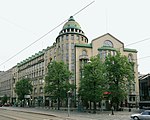Central Railway Station metro station (Helsinki)

The Central Railway Station metro station (Finnish: Rautatientorin metroasema, Swedish: Järnvägstorgets metrostation) is a station on the Helsinki Metro. The entrance is located in the Asematunneli main hall, which has an exit to the Helsinki Central Railway Station. It is among the only Helsinki Metro stations whose names are announced in English, in addition to Finnish and Swedish. As one of the original metro stations, Central Railway Station was opened on 1 July 1982 and was designed by Rolf Björkstam, Erkki Heino, and Eero Kostiainen. It is located 0.5 kilometres (0.31 mi) from Kamppi metro station, and 0.6 kilometres (0.37 mi) from University of Helsinki metro station. The station is situated at a depth of 27 metres (89 ft) below ground level and 22 metres (72 ft) below sea level. On 8 November 2009 a water main burst, flooding and causing significant damage to the underground station complex. On February 15, 2010 the station reopened for public use.
Excerpt from the Wikipedia article Central Railway Station metro station (Helsinki) (License: CC BY-SA 3.0, Authors, Images).Central Railway Station metro station (Helsinki)
Compass level, Helsinki City Centre (Southern major district)
Geographical coordinates (GPS) Address Nearby Places Show on map
Geographical coordinates (GPS)
| Latitude | Longitude |
|---|---|
| N 60.170555555556 ° | E 24.940555555556 ° |
Address
Kaivokatu
Compass level
00101 Helsinki, City Centre (Southern major district)
Finland
Open on Google Maps











